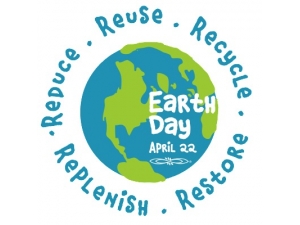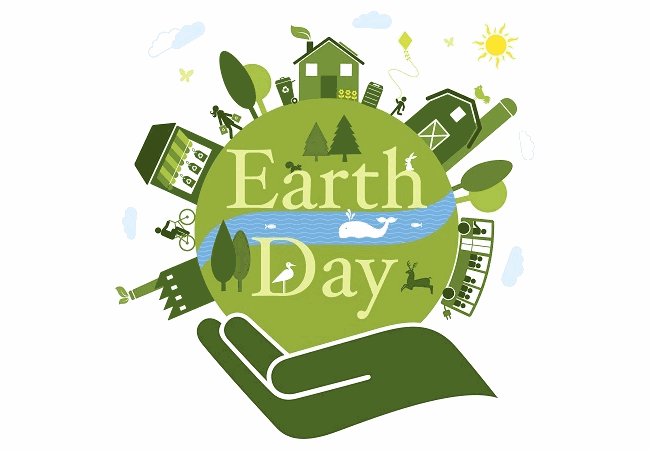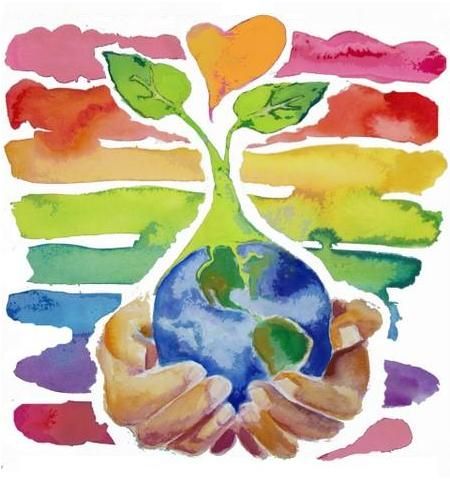Celebrating Earth Day, Every Day, at La Basse Cour
4/22/19, 7:04 AM
By: Diane Frances
Coming of age in the 1970s I was acutely aware of the degraded state of our environment and the causes, and the impact that was having on people here and around the world. Thanks to Gaylord Nelson, I also began to understand the power we have as a people to create large and lasting change for the good. 
What we call today the global economy had been taking shape since the end of WWII, the result of unfettering capitalism from controls put in place after the Dust Bowl and the Great Depression in the 1930s. Many saw this period as a golden age of progress, and in many ways it was. The pace of discovery and innovation, of technological advancement and production of food and energy and goods and wealth was breathtaking. While it came at a cost to our environment and to many lives, this was accepted as the price of progress and created the expectation that all problems could be solved through technology and the free market.
Others were more circumspect. Gaylord Nelson was one such person. We may know him as the Founder of Earth Day on April 22, 1970, but his insights and leadership date back to his days as a State Senator in his home state of Wisconsin in the 1950s. Nelson was keenly aware of the shared plight of both the urban and rural poor as the social and ecological costs of technological innovation and industrial expansion. "Environment is all of America and its problems. It is rats in the ghetto. It is a hungry child in a land of affluence. It is housing not worthy of the name; neighborhoods not fit to inhabit."
Nelson's words resonated with Wisconsin residents since they too had grown increasingly concerned with the exploitation of public resources by private industry, the pollution of the state's waterways and their dilapidated state parks. Nelson promised comprehensive reforms and was elected to two terms as governor. He established unprecedented high levels of public funding for education, health care, unemployment, highways, and urban and rural development. He was walking the talk, implementing many of the ideas that are the basic elements of The Green New Deal well before this framework for comprehensive action was envisioned.
In 1962 Nelson was elected to the US Senate where he contributed to important social and economic reforms but struggled to interest his colleagues in environmental protections. He believed in the power of the people as well as the government’s ability to promote the public good, so he turned to the people and proposed April 22, 1970 as a day for Americans to speak out about the environmental crises they faced in their own communities. An estimated 20 million Americans came together on April 22, 1970 to confront the ecological problems in their cities, states, our nation, and our planet—and to demand action from themselves and from their elected officials.
It was a watershed moment. Earth Day's massive public support forced politicians to see the severity of the problems and the extent of public concern. The first Earth Day galvanized Congress into creating some of the most important U.S. environmental legislation ever enacted including: the Clean Water Act, the National Wild and Scenic Rivers Act, the Federal Pesticides Act, the Clean Air Act, the Environmental Education Act, the National Hiking Trails and the National Scenic Trails Acts, and the establishment of the Apostle Islands National Lakeshore.
 As a result, much clean up and restoration occurred as environmental impacts were assessed and limited for industrial and commercial projects throughout the nation. Health and environmental improvements were measurable: less air pollution resulting in lower incidences and severity of respiratory ailments, less water pollution resulting in cleaner drinking water and the return of fish and amphibians in lakes, rivers and streams throughout America. Hazardous waste discharges were regulated and toxic waste sites cleaned. Exposure to workplace toxins were controlled, potential impacts of newly invented chemicals were assessed before being allowed to be introduced to the market place. Pesticides such as DDT were banned, enabling the bald eagle, the symbol of American freedom, to return from almost complete extinction. Several generations of Americans grew up in this much cleaner and much safer and much more beautiful environment, many never knowing how close to the brink we had come.
As a result, much clean up and restoration occurred as environmental impacts were assessed and limited for industrial and commercial projects throughout the nation. Health and environmental improvements were measurable: less air pollution resulting in lower incidences and severity of respiratory ailments, less water pollution resulting in cleaner drinking water and the return of fish and amphibians in lakes, rivers and streams throughout America. Hazardous waste discharges were regulated and toxic waste sites cleaned. Exposure to workplace toxins were controlled, potential impacts of newly invented chemicals were assessed before being allowed to be introduced to the market place. Pesticides such as DDT were banned, enabling the bald eagle, the symbol of American freedom, to return from almost complete extinction. Several generations of Americans grew up in this much cleaner and much safer and much more beautiful environment, many never knowing how close to the brink we had come.
In 1995, the 25th Anniversary of Earth Day, Gaylord Nelson was awarded the Presidential Medal of Freedom, the nation's highest honor for civilians. He offered this challenge:
"The opportunity for a gradual but complete break with our destructive environmental history and a new beginning is at hand.... We can measure up to the challenge if we have the will to do so — that is the only question. I am optimistic that this generation will have the foresight and the will to begin the task of forging a sustainable society."
Also in 1995, Sherwood Rowland, Mario J. Molina and Paul J. Crutzen shared in the Nobel Prize in Chemistry for their research on the devastating effects of chlorofluorocarbons – CFCs – on the ozone in our atmosphere that is necessary to absorb ultraviolet radiation from the sun. Their work, published in the prestigious scientific journal Nature, set off heated debates that soon led to a global environmental treaty restricting their use, spurring innovation for a replacement for this widely used refrigerant, and changing the way we viewed our impact on Earth’s environment. It seemed we were beginning to live up to Nelson’s challenge.
Since then, the relentlessness of the global economy has overwhelmed our environment’s ability to absorb its wastes, especially CO2 from the burning of fossil fuels, and our society’s calls for justice. In 2006, through the film An Inconvenient Truth, we were once again brought face to face with the consequences of our choice of the economy over people and our environment. The response, however, was different. Instead of the scientific community, politicians, corporations and citizens coming together to address the global threat as was done with CFCs, scientists have been undermined, corporations have hidden information and politicians have been complicit as they foster the denial that has enabled inaction, and citizens have been left confused and dismayed. The clock is ticking. The UN recently issued a warning that significant action must be taken within 12 years or it will be impossible for our planetary life support systems to respond before CO2 levels rise to the point when we will experience the 6th mass extinction in the history of Earth. Once again we are at the brink.
Yet it is not all doom and gloom. Nelson’s optimism is alive and well in many. There has been a dramatic awakening to the fragility of our planetary systems and to how we as humans are causing not only their breakdown, but also geopolitical instability and suffering because of our insatiable hunger for cheap energy, cheap food, and cheap resources. The scientific consensus is now beyond doubt. People are calling for action, this time in the form of a comprehensive approach called the Green New Deal. It is a proposed framework for addressing climate change and creating a more sustainable, more just society. The Green New Deal calls for environmental, economic and social justice – the three aspects of life on our planet for all that must be brought back into balance if we are to forge the sustainable society to which Nelson called us to action. It calls for a mobilization on all three fronts on the scale of the response to The Great Depression, The Dust Bowl and WWII, the original New Deal. No one aspect can trump another if we are to make our way through this crisis of our time, together. Society, our economy, and our environment are inextricably linked. One cannot thrive without the other two.
 We’re doing our part at La Basse Cour and at Kortright Handworks, farming sustainably, creating durable goods from nature’s gifts, teaching and learning with our visitors and guests about the options available today and about ways to create more and better options for our future. We compost all of our farm animal manure and bedding and return it to feed the soil. We plant cover crops to naturally add nitrogen to the soil with legumes and keep the soil covered to prevent erosion. We rotationally graze our pastures to optimize plant, soil and animal health. We protect our wetlands and don’t use them for agriculture. We never use synthetic chemicals so that we protect the biological life in the soil as well as our pollinators. We’re moving to baleage to reduce tractor fuel for haymaking and increase nutrient availability for our farm animals at the same time. We’re using only natural dyes from locally sourced plant materials for our yarn. Our firewood is sustainably harvested. We sell and serve local food products from natural sources and grass fed animals, supporting our local economy at the same time. There is much more we can do, will do, in time. Our transition, our transformation, is a gradual, thoughtful, process all aimed toward a sustainable future for us, as part of a sustainable community and world.
We’re doing our part at La Basse Cour and at Kortright Handworks, farming sustainably, creating durable goods from nature’s gifts, teaching and learning with our visitors and guests about the options available today and about ways to create more and better options for our future. We compost all of our farm animal manure and bedding and return it to feed the soil. We plant cover crops to naturally add nitrogen to the soil with legumes and keep the soil covered to prevent erosion. We rotationally graze our pastures to optimize plant, soil and animal health. We protect our wetlands and don’t use them for agriculture. We never use synthetic chemicals so that we protect the biological life in the soil as well as our pollinators. We’re moving to baleage to reduce tractor fuel for haymaking and increase nutrient availability for our farm animals at the same time. We’re using only natural dyes from locally sourced plant materials for our yarn. Our firewood is sustainably harvested. We sell and serve local food products from natural sources and grass fed animals, supporting our local economy at the same time. There is much more we can do, will do, in time. Our transition, our transformation, is a gradual, thoughtful, process all aimed toward a sustainable future for us, as part of a sustainable community and world.
Next year, 2020, marks the 50th Anniversary of Earth Day. As the first Earth Day sparked what is known as “The Environmental Decade” of vast and sweeping action to change the practices that brought us to our first brink, my hope is that this time we’ll come together to create a Green New Deal that benefits all of us, all of life, and our planet Earth. We’ve only got one and she deserves our love, our respect, and our care. Happy Earth Day. Let's make it every day.
Learn more about Earth Day at The Earth Day Story and Gaylord Nelson.

 As a result, much clean up and restoration occurred as environmental impacts were assessed and limited for industrial and commercial projects throughout the nation. Health and environmental improvements were measurable: less air pollution resulting in lower incidences and severity of respiratory ailments, less water pollution resulting in cleaner drinking water and the return of fish and amphibians in lakes, rivers and streams throughout America. Hazardous waste discharges were regulated and toxic waste sites cleaned. Exposure to workplace toxins were controlled, potential impacts of newly invented chemicals were assessed before being allowed to be introduced to the market place. Pesticides such as DDT were banned, enabling the bald eagle, the symbol of American freedom, to return from almost complete extinction. Several generations of Americans grew up in this much cleaner and much safer and much more beautiful environment, many never knowing how close to the brink we had come.
As a result, much clean up and restoration occurred as environmental impacts were assessed and limited for industrial and commercial projects throughout the nation. Health and environmental improvements were measurable: less air pollution resulting in lower incidences and severity of respiratory ailments, less water pollution resulting in cleaner drinking water and the return of fish and amphibians in lakes, rivers and streams throughout America. Hazardous waste discharges were regulated and toxic waste sites cleaned. Exposure to workplace toxins were controlled, potential impacts of newly invented chemicals were assessed before being allowed to be introduced to the market place. Pesticides such as DDT were banned, enabling the bald eagle, the symbol of American freedom, to return from almost complete extinction. Several generations of Americans grew up in this much cleaner and much safer and much more beautiful environment, many never knowing how close to the brink we had come. We’re doing our part at La Basse Cour and at Kortright Handworks, farming sustainably, creating durable goods from nature’s gifts, teaching and learning with our visitors and guests about the options available today and about ways to create more and better options for our future. We compost all of our farm animal manure and bedding and return it to feed the soil. We plant cover crops to naturally add nitrogen to the soil with legumes and keep the soil covered to prevent erosion. We rotationally graze our pastures to optimize plant, soil and animal health. We protect our wetlands and don’t use them for agriculture. We never use synthetic chemicals so that we protect the biological life in the soil as well as our pollinators. We’re moving to baleage to reduce tractor fuel for haymaking and increase nutrient availability for our farm animals at the same time. We’re using only natural dyes from locally sourced plant materials for our yarn. Our firewood is sustainably harvested. We sell and serve local food products from natural sources and grass fed animals, supporting our local economy at the same time. There is much more we can do, will do, in time. Our transition, our transformation, is a gradual, thoughtful, process all aimed toward a sustainable future for us, as part of a sustainable community and world.
We’re doing our part at La Basse Cour and at Kortright Handworks, farming sustainably, creating durable goods from nature’s gifts, teaching and learning with our visitors and guests about the options available today and about ways to create more and better options for our future. We compost all of our farm animal manure and bedding and return it to feed the soil. We plant cover crops to naturally add nitrogen to the soil with legumes and keep the soil covered to prevent erosion. We rotationally graze our pastures to optimize plant, soil and animal health. We protect our wetlands and don’t use them for agriculture. We never use synthetic chemicals so that we protect the biological life in the soil as well as our pollinators. We’re moving to baleage to reduce tractor fuel for haymaking and increase nutrient availability for our farm animals at the same time. We’re using only natural dyes from locally sourced plant materials for our yarn. Our firewood is sustainably harvested. We sell and serve local food products from natural sources and grass fed animals, supporting our local economy at the same time. There is much more we can do, will do, in time. Our transition, our transformation, is a gradual, thoughtful, process all aimed toward a sustainable future for us, as part of a sustainable community and world.
